The use of information about a patient's genotype in order to select a medication or therapy that is specifically suited to the patient is called
personalized medicine
Approximately how many human diseases have a genetic basis?
Thousands
True or false: A disease with a genetic origin in a mouse is unlikely to be an inherited disease in humans.
False
Which observations are consistent with a disease having a genetic basis?
A cancerous growth of immature nerve cells called neuroblastoma is associated with a deletion in a specific region of chromosome 11.
The sleep disorder called narcolepsy has been related to an allele for a faulty neural receptor in dogs. Some humans also suffer from narcolepsy.
Tay-Sachs disease can occur in 1/2500 births in a specific eastern European population while the frequency is 1/250,000 across Europe.
True or false: Identical twins share a genetic disease more often than fraternal twins.
True
Reason:
Identical twins share 100% of the same genetic material.
Personalized medicine can be used to select a ______.
medication
therapy
preventative measure
Monozygotic twins ______.
share 100% of the same alleles
When a defect in a single gene causes a human disease, the mutant gene often follows ______.
simple Mendelian inheritance patterns
Dizygotic twins ______.
share an average of 50% of the same alleles
True or false: Comparing someone with a genetic disease to another person in the general population, the person with the disease is more likely to have a family member with the same disease.
True
Nontraumatic epilepsy shows a concordance of 70% for monozygotic twins and 6% for dizygotic twins. This demonstrates that nontraumatic epilepsy is a ______.
genetic disease
Select observations that are consistent with a disease having a genetic basis.
A person with a disease is more likely to have genetic relatives with the disease than are people in the general population.
The disease has a characteristic age of onset.
A human disorder may resemble a disorder known to have a genetic basis in animals.
The disease doesn't spread to individuals sharing similar environmental situations.
Identical twins share the disease more often than non-identical twins.
Different populations tend to have different disease frequencies.
There is a correlation between a human disease and a mutant gene or chromosomal alteration.
True or false: Dizygotic twins share a genetic disease more frequently than monozygotic twins.
False
Reason:
Dizygotic twins share an average of 50% of the same genes while monozygotic twins share 100% of the same genes.
What tool do scientists use to follow a human pattern of inheritance from generation to generation?
Pedigree analysis
Twins that are genetically identical to each other are called ______ twins.
monozygotic
Twins that share about 50% of their genetic material are called ______ twins.
dizygotic
When a human disease is caused by a mutation in a single gene, the pattern of inheritance is called ___ Mendelian inheritance.
simple
In one study, autism showed 60% concordance for monozygotic twins and 0% concordance for dizygotic twins. This demonstrates that autism is ______.
a genetic disease
Reason:
A higher rate of the condition in identical than non-identical twins demonstrates that the disease has a genetic basis.
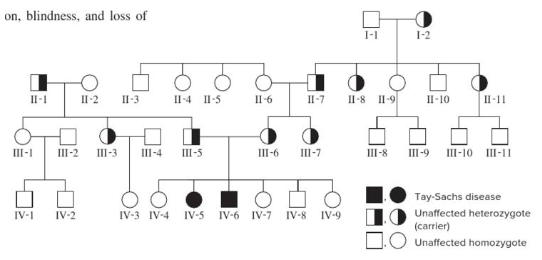
Select all that apply
Which of the following characteristics of inheritance can be observed in the accompanying pedigree of a family affected by Tay-Sachs disease?
An affected offspring can have two unaffected parents.
Affected individuals are offspring of heterozygous parents.
The trait occurs in both males and females.
When a human disease is caused by a mutation in a single gene, scientists follow the pattern of inheritance by analyzing charts called human
pedigrees
What is the inheritance pattern when a trait occurs with the same frequency in both sexes and an affected offspring can have two unaffected parents?
Autosomal recessive
Reason:
An affected offspring will have at least one affected parent in autosomal dominant inheritance.
Select the human disorders that are inherited in an autosomal recessive fashion.
Phenylketonuria
Cystic fibrosis
Sickle cell disease
Simple Mendelian inheritance is a pattern observed when a human disorder is caused by ______.
mutation in a single gene
Reason:
Simple Mendelian inheritance also applies to diseases caused by recessive alleles.
Reason:
Simple Mendelian inheritance also applies to diseases caused by dominant alleles.
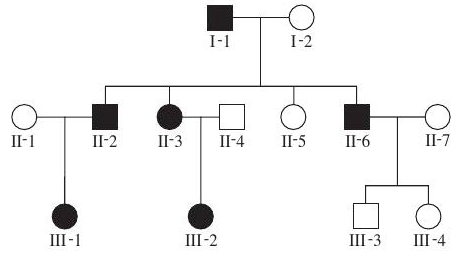
Select all that apply
In the accompanying pedigree, a filled symbol indicates an individual with Huntington disease while a clear symbol shows an unaffected individual. Which of the following characteristics of inheritance can be observed for this affected family?
An affected individual has at least one affected parent.
The trait occurs in both males and females.
What is the inheritance pattern for a trait that occurs with equal frequency in both sexes and will be inherited, on average, by 50% of the offspring of an affected individual who had only one affected parent?
Autosomal dominant
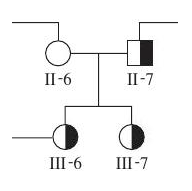
Consider the children of II-6 and II-7 in the accompanying pedigree for a family affected by Tay-Sachs disease. What is one genotype that could have been produced by these two parents but was not observed?
Unaffected homozygote
Reason:
A heterozygote would be unaffected by Tay-Sachs disease.
Reason:
Only one parent carries the Tay-Sachs allele.
Reason:
11-6 and 11-7 are unaffected heterozygotes.
What is the inheritance pattern when the trait occurs with the same frequency in both sexes and two unaffected heterozygotes have, on average, 25% affected children?
Autosomal recessive
A dominant genetic disorder can be caused by a ______ mutation, where the product of an altered gene gains a new or abnormal function.
gain-of-function
The autosomal recessive human disorder albinism (type I) is caused by a mutation in the gene for ______.
tyrosinase
Select all that apply
Select human disorders inherited in an autosomal dominant fashion.
Marfan syndrome
Aniridia
Huntington disease
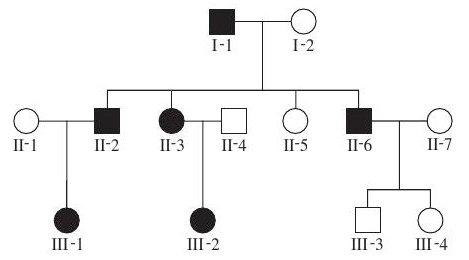
In the accompanying pedigree, a filled symbol indicates an individual with Huntington disease while a clear symbol shows an unaffected individual. Considering the symbol for individual II-5, you conclude that her father, I-1 is ______ allele for Huntington disease.
heterozygous for the autosomal dominant
Reason:
Huntington disease is an autosomal dominant trait.
Reason:
Huntington disease is an autosomal dominant trait which will be expressed when at least one dominant allele is present.
Reason:
If the father was homozygous dominant for the allele, II-5 would have received the dominant allele and be affected.
What is the inheritance pattern for a trait that occurs with the same frequency in both sexes and two affected heterozygous individuals have, on average, 25% unaffected offspring?
Autosomal dominant
Reason:
For this pattern, two affected individuals (who would not be heterozygotes), would have 0% unaffected offspring.
A dominant genetic disorder can be caused by ______, a situation where one functional copy of an allele is not sufficient to produce a normal phenotype.
haploinsufficiency
Select all that apply
Select human diseases that are inherited in an X-linked recessive fashion.
Hemophilia A
Androgen insensitivity syndrome
Duchenne muscular dystrophy
Marfan syndrome, which is inherited in an autosomal dominant manner, is caused by a mutation in the gene for ______.
fibrillin-1
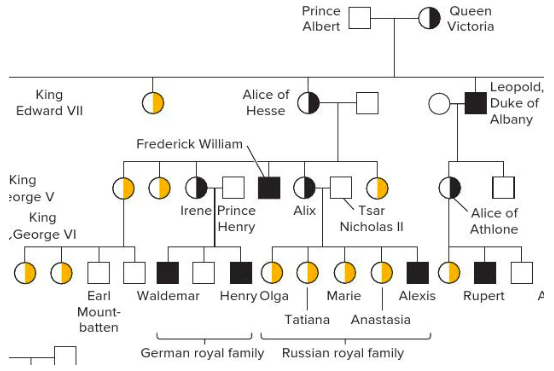
Select all that apply
Consider the accompanying partial pedigree showing inheritance of hemophilia in the family of Queen Victoria and Prince Albert. If X h is the allele for hemophilia and X H is the allele for normal blood clotting, which genotypes are missing among the children of Alice of Hesse and her husband, in the middle of the figure?
X H X H
X H Y
What is the inheritance pattern for a trait that more commonly affects males than females and can often be observed in brothers or fathers of a woman who has affected sons?
X-linked recessive
Reason:
An X-linked dominant trait would be passed to both sons and daughters of an affected mother
What is the inheritance pattern for a trait that is more likely to occur in females when it is lethal to males?
X-linked dominant
Duchenne muscular dystrophy, which is inherited in an X-linked recessive manner, is caused by a mutation in the gene for ______.
dystrophin
Rett syndrome, which is inherited in an X-linked dominant manner, is caused by a mutation in the gene for ______.
methyl-CpG-binding protein-2
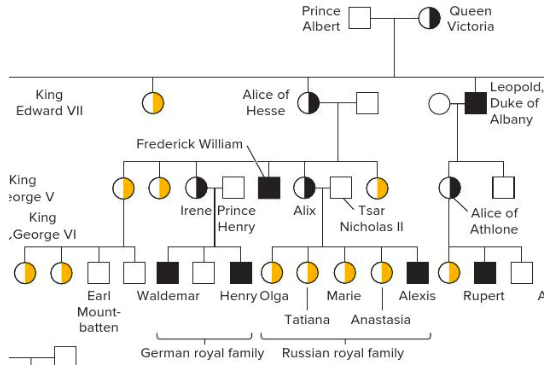
Select all that apply
Which of the following characteristics of inheritance for hemophilia can be observed in the accompanying partial pedigree for the family of Queen Victoria and Prince Albert?
Males are more likely to be affected than females.
Mothers of affected males often have brothers with the disease.
What is the inheritance pattern for a trait that more commonly affects males than females and which will occur in about 50% of the sons born to the unaffected daughter of an affected male?f
X-linked recessive
Reason:
Since the daughter is unaffected, the trait must be inherited as an X-linked recessive.
Which statement is true of X-linked dominant disorders such as Rett syndrome and Aicardi syndrome?
Males die at an early stage of development
The disease hemophilia is caused by a deficiency in any one of three blood clotting factors. Two of these factors are encoded by genes on the X chromosome and the other clotting factor gene is located on an autosome. Since mutations in more than one gene can cause hemophilia, this represents ______.
locus heterogeneity
Reason:
Heterozygosity refers to one locus rather than a situation where more than one gene affects the same disease.
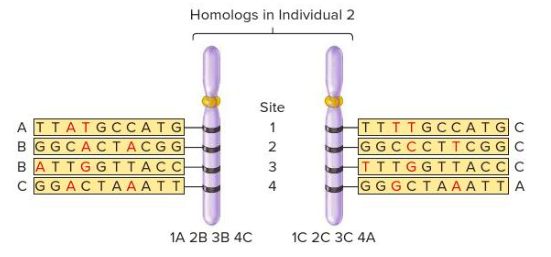
Consider the accompanying figure showing four variable sites along a chromosome that can have any of three different versions, A, B or C, at each site. For this individual, the listing 1C 2C 3C 4A is a ______.
haplotype
Select all that apply
Select human disorders that are inherited in an X-linked dominant manner.
Rett syndrome
Vitamin-D resistant rickets
Incontinentia pigmenti
Which best describes a haplotype?
A haploid genotype showing linkage of alleles or molecular markers along a single chromosome
Reason:
Linked alleles or molecular markers in a region of a chromosome form a haplotype.
Which factor is likely to contribute to a change in a haplotype between generations?
Crossing over between molecular markers that are spaced far apart on the chromosome
An association between a disease-causing allele and nearby molecular markers can be established because ______.
haplotypes do not usually change from generation to generation
A situation where a disease may be caused by mutations in two or more different genes is called ______.
locus heterogeneity
Reason:
A pleiotropic effect involves one gene having multiple phenotypic effects.
Reason:
Locus heterozygosity involves different alleles of the same gene or locus.
A single individual who first had a disease-causing allele is called a
founder
If alleles and molecular markers are associated with each other at a frequency greater than expected by random chance, the situation is described as ______.
linkage disequilibrium
The linkage of alleles or molecular markers along a single chromosome is called a ______.
haplotype
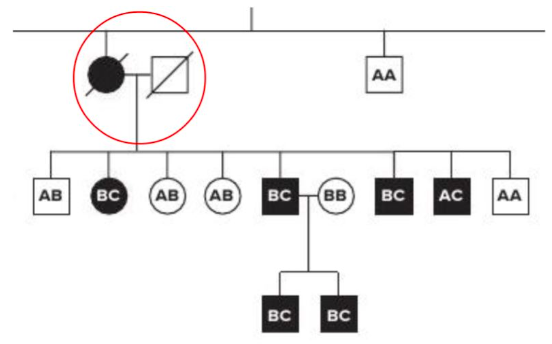
The accompanying pedigree shows the inheritance of Huntington disease with filled symbols and also indicates which combination of four possible forms (A, B C, D) of a molecular marker called G8 that the person has inherited. What is the one possible phenotype and marker combination that is missing among the children of the couple surrounded by the circle?
BB with Huntington disease
Reason:
The G8-C marker is associated with Huntington disease.
Haplotypes are relatively stable from one generation to the next because ______.
crossing over is unlikely to occur for molecular markers that are close to each other
mutations that would change the haplotype are rare
Click and drag on elements in order
You are trying to identify the mutant gene responsible for a human disease. You have performed haplotype association, which has identified a short chromosomal region associated with the disease. Place the next steps you should take to identify the gene in order, placing the first step at the top.

When a new mutation establishes a disease-causing allele in a family member, the allele's location can be traced through ______.
markers in a haplotype that are located nearby
Fill in the blank question.
Once a disease-causing allele is identified, progress can often be made on developing ___ to treat the disease and genetic ___ to enable people to determine if they carry the disease-causing allele.
therapies, strategies, or drugs
tests or testing
The first individual who carried a disease called allele is called a ______.
founder
A worldwide effort to identify human genetic variation observed for SNPs and other variants is called the International ___ Project.
HapMap
Linkage disequilibrium is a(n) ______
higher level of association between a disease allele and a molecular marker than would be expected by chance
The purpose of the HapMap project is to ______.
collect and organize information about human genetic variation
Reason:
The Hap Map project documents variation, allowing other researchers to search for links to disease-causing alleles.
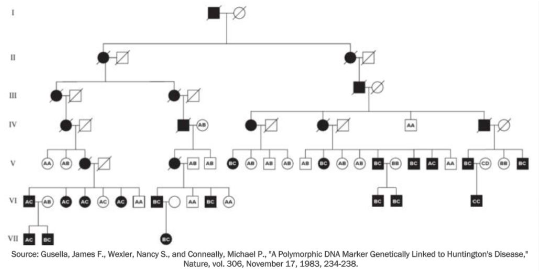
The accompanying pedigree shows the inheritance of Huntington disease with filled symbols and also indicates which combination of four possible forms (A, B C, D) of a molecular marker called G8 that the person has inherited. Although there are some exceptions, the inheritance of Huntington disease is most closely associated with which form of the G8 marker in this pedigree?

C
An examination of the genomes of many different individuals to determine if a specific genetic variant is associated with a human disease is called a genome-wide ___ ___.
association
study
To determine which gene in a chromosomal region is responsible for a specific disease, which of the following steps would be used LAST?
Sequence a candidate gene from both affected and unaffected individuals.
Other answer possibilities:
Determine whether a candidate gene is active in the cell type that would be affected by the disease.
Sequence a candidate gene from both affected and unaffected individuals.
Identify a set of candidate genes with a haplotype association study.
Use published DNA sequences to identify 5-10 genes located in the chromosomal region identified by haplotype association studies.
Select all that apply
Identifying disease-causing alleles is useful for ______.
Multiple select question.
developing genetic tests to identify allele carriers
developing strategies for treating the disease
understanding how genes contribute to the development of the disease
The International HapMap Project is an effort to identify differences in human DNA sequences by identifying ______.
single-nucleotide polymorphisms
In a genome-wide association study, the goal is to identify ______ which show a significantly different frequency between a control group and a group of individuals affected by a specific disease.
single-nucleotide polymorphisms (SNPs)
Researchers studying disease-causing genes can use information found in a catalog of common human genetic variants called the
Hap Map project.
Reason:
Variation is documented in the Hap Map project.
The odds ratio is the odds of ______ a disease for individuals carrying a specific SNP versus the odds of ______ a disease for individuals not carrying the same SNP.
having; having
The goal of a ______ study is to find a relationship between one or more single-nucleotide polymorphisms (SNPs) and a disease or other human trait.
genome-wide association
Which represents a way to visualize the results of a genome-wide association study?
Manhattan plot
For SNPs shown to have a cause-and-effect relationship with a specific disease, which type(s) of changes may be observed?
For SNPs shown to have a cause-and-effect relationship with a specific disease, which type(s) of changes may be observed?
To study the distribution of disease-causing genes, genetic ______ refers to determining if an individual carries the faulty gene, while genetic ______ relates to assessing the presence of the gene throughout a population.
testing; screening
To conduct a genome-wide association study, the ______ of a large group of individuals who are afflicted with the same disease are compared to those of a large group of people without the disease.
single-nucleotide polymorphisms (SNPs)
Suppose a disease-causing allele shows autosomal recessive inheritance. How could a carrier of this disease-causing allele be identified?
Carriers often show reduced activity for the enzyme encoded by the allele.
Reason:
Carriers will still have two copies of the disease-causing allele, one will be functional and the other will be non-functional.
To identify SNPs for which the frequency is significantly different between a control group and a group of individuals affected by a disease, a(n) ___ ___ is determined and its significance can be evaluated based on the calculation of a(n) ___ value.
odds
ratio
P

The data shown in the figure represent the results of a ______ study for human chromosomes 1 through 12.

genome-wide association
Reason:
The plotted data includes SNPs that can be found in non-genic regions.
Which changes can be represented in an SNP identified to have an cause-and-effect relationship with a specific disease through genome-wide association studies?
A change in the coding sequence of a gene
A change in the promoter region of a gene
A change in a regulatory sequence such as an enhancer
Genetic testing is used to determine whether a(n) ______ has a disease-causing gene, while genetic screening is used to determine how frequently the gene is found in a(n) ______.
individual; population
Select all that apply
Which methods can be used at the DNA level to test for specific mutations related to a genetic disease?
DNA microarray analysis
DNA sequencing
Fluorescence in situ hybridization (FISH)
Click and drag on elements in order
Tay-Sachs disease is inherited with an autosomal recessive allele that leads to a defect in the enzyme hexosaminidase A. When cells are collected from patients, cells with different genotypes exhibit different amounts of enzymatic activity. Rank the amount of enzymatic activity that would be detected in a biochemical assay on cells from patients of these genotypes, with the genotype producing the LEAST amount of enzymatic activity on top.
InstructionsChoice 1 of 3. Homozygous recessive toggle button
Homozygous recessive
Choice 2 of 3. Homozygous dominant toggle button
Homozygous dominant
Choice 3 of 3. Heterozygous toggle button
Heterozygous

A karyotype can be used to ______.
identify changes in chromosome number and structure associated with a disease condition
Which of these is a common example of widespread genetic screening of newborns to identify certain disorders?
Test for excess phenylalanine indicating phenylketonuria (PKU)
Select all that apply
Which of the following are areas of social and ethical concern regarding genetic testing and screening?
Distress over learning about carrying the gene for an incurable disease
Potential discrimination in obtaining jobs or medical insurance
Other answer selections:
Costs of DNA sequencing and microarray analysis
Overuse of therapeutic drugs designed to treat inherited diseases
A method for obtaining fetal cells in a sample of the fluid surrounding the fetus is called ______.
amniocentesis
Which method can be used at the DNA level to detect the presence of a specific mutation in a disease-causing allele?
DNA microarray analysis
Chromosomal abnormalities related to genetic diseases can be detected by ______.
producing a karyotype
Reason:
DNA microarray analysis can be used to detect gene differences but will not show large scale chromosomal differences.

Match the life stage on the left to the type of screening on the right that would be used to detect a genetic disease.

A small portion of the fetal part of the placenta is removed to prepare a karyotype in the process called ______.
chorionic villus sampling
Reason:
Amniocentesis involves the removal of amniotic fluid which contains fetal cells.
One concern associated with genetic testing and screening is the potential for misuse of private information including ___ by employers or insurance providers.
discrimination
Embryos produced by in vitro fertilization can undergo genetic testing by ______.
preimplantation genetic diagnosis
Amniocentesis is a procedure for ______.
obtaining fetal cells in a sample from the fluid surrounding the fetus
In vitro fertilization is a procedure in which ______.
sperm and egg are combined outside the mother's body
What is the source of cells used in preimplantation genetic diagnosis?
Cells from an eight-cell stage embryo
Select all that apply
Which of the following are infectious diseases caused by prions?
Mad cow disease
Kuru
Scrapie
Chorionic villus sampling is a procedure for ______.
obtaining a sample of the fetal part of the placenta
Preimplantation genetic diagnosis is a method testing for genetic diseases in ______.
embryos produced by in vitro fertilization
A procedure in which sperm and egg are combined outside a mother's body is called ______.
in vitro fertilization
A disease-causing agent made only of protein is called a ______.
prion
Click and drag on elements in order
Place the steps of preimplantation genetic diagnosis in the correct order with the first step at the top.

Abnormal form of the prion protein
Reason:
Consuming animal products from an animal with prion disease may induce prion disease development.
Select all that apply
Which of the following are human inherited diseases that are caused by prions?
Multiple select question.
Familial fatal insomnia
Creutzfeldt-Jakob disease
Which type of catalytic activity occurs in prion-caused diseases?
The abnormal form of the prion protein catalyzes a reaction that converts normal proteins to misfolded ones.
Gene ___ is the introduction of cloned genes into somatic cells to treat disease.
therapy
A prion is a disease-causing agent made ______.
only of protein
Select all that apply
Gene therapies were approved by the FDA in 2017 for which of the following diseases?
Multiple select question.
B-cell acute lymphoblastic leukemia
Non-Hodgkin lymphoma
Select all that apply
How can abnormal forms of the prion protein arise within an individual?
A person may have inherited an allele that causes their normal prion protein to convert to an abnormal one at a low rate.
A person can be infected by eating meat from an animal with the disease.
Select the types of diseases that are being investigated as potential targets for gene therapy.
Muscular
Blood
Lung
Metabolic
Cancer
The abnormal form of a prion protein causes a neurodegenerative disease by ______.
catalyzing the conversion of the normal protein form to the abnormal form
What types of human diseases are the most straightforward targets for gene therapy?
Inherited diseases involving a single gene abnormality
Click and drag.
Place the steps by which a cloned gene is transfered into human cells via liposomes in order, with the first step at the top.

Two gene therapies that target ___ system cells were approved in 2017, to treat B-cell acute lymphoblastic leukemia and non-Hodgkin lymphoma.
immune
An advantage of using liposomes as vectors to transfer cloned genes is that liposomes ______.
do not elicit an immune response
What can cause prion disease in humans when the products of an affected animal are consumed?
Abnormal form of the prion protein
Click and drag on elements in order
Place the steps by which a cloned gene is transferred into human cells using a retroviral technique in order, with the first step at the top.

Sickle cell disease, hemophilia, and SCID are all diseases for which gene therapy may be useful. What type of disease are these?
Blood
Scientists have been working on reducing the inflammatory response evoked by ___ vectors, to improve the safety of gene therapy.
virus, viral, adenovirus, adenoviral, retrovirus, or retroviral
One form of severe combined immune deficiency disease (SCID) is caused by inheriting two defective copies of the ______ gene that encodes an enzyme involved in purine metabolism crucial to the maintenance of healthy immune system cells.
ADA
The most common nonviral technique to transfer a cloned gene into human cells involves lipid vesicles called
liposomes
A major disadvantage of using liposomes as vectors to transfer cloned genes is ______.
low gene transfer efficiency
A patient with ADA deficiency can be treated with a bone marrow ___, injections of purified ___ enzyme coupled with polyethylene glycol, or gene ___.
transplant
ADA, adenosine deaminase, or adenosinedeaminase
therapy
In which way are viruses used for gene transfer different from their wild-type counterparts?
Viruses used in gene transfer cannot replicate within target cells.
Reason:
Viruses used for gene transfer can still be targeted by the immune system.
The major disadvantage to using viral vectors to transfer cloned genes is ______.
the potential for an immune response
Click and drag on elements in order
Place the steps used to treat a patient with adenosine deaminase deficiency via gene therapy in order, with the first step at the top.
InstructionsChoice 1 of 4. The retroviral genetic material was inserted into the chromosomal DNA of the lymphocytes. toggle button
The retroviral genetic material was inserted into the chromosomal DNA of the lymphocytes.
Choice 2 of 4. The lymphocytes were transfected with a retrovirus that had been genetically engineered to contain the normal ADA gene. toggle button
The lymphocytes were transfected with a retrovirus that had been genetically engineered to contain the normal ADA gene.
Choice 3 of 4. The lymphocytes were reintroduced back into the patient. toggle button
The lymphocytes were reintroduced back into the patient.
Choice 4 of 4. Lymphocytes were removed from the patient and cultured in the lab. toggle button
Lymphocytes were removed from the patient and cultured in the lab.

If both copies of the ___ gene are defective, deoxyadenosine accumulates within the individual, which can lead to a severely compromised ___ system.
ADA
immune
When an experiment or treatment involves genetic manipulation outside of the body, followed by reintroduction into the body, it is called an ______ approach.
ex vivo
Several patients receiving gene therapy for SCID-X1 developed ___, which was caused by integration of the retroviral vector next to a particular gene in the patients' genomes.
leukemia or cancer
Select treatments for patients with adenosine deaminase (ADA) deficiency.
Gene therapy
Bone marrow transplant
PEG-ADA treatment
Molecular profiling is ______.
identification of the genes that play a role in the development of a specific type of cancer
Reason:
Molecular profiling relates to detection of genetic changes.
Reason:
Molecular profiling is applied after a tumor has developed.
The gene delivery system used to treat adenosine deaminase deficiency in the first human gene therapy was ______.
retroviruses
Reason:
The normal gene for ADA was cloned into a retroviral vector that can infect lymphocytes.
A technique where genetic manipulations occur outside of the body, and then the products are reintroduced into the body is called a(n) ___ ___ approach.
ex vivo
The drug tamoxifen has been used to prevent overexpression of estrogen receptors for a specific and effective breast cancer treatment. Development of drugs that target proteins unique to certain types of cancer is an outcome of
molecular profiling.
The gene therapy trial to treat SCID-X1 ______.
was the first clear demonstration that gene therapy can offer clinical benefit
Reason:
This trial was the first demonstration that gene therapy could correct a disease phenotype.
Reason:
This relates to a clinical trial to treat ADA deficiency inherited through a mutation in an autosomal rather than an X-linked gene.
Which method can identify genes that are active in cancer cells but inactive in normal cells?
DNA microarray analysis
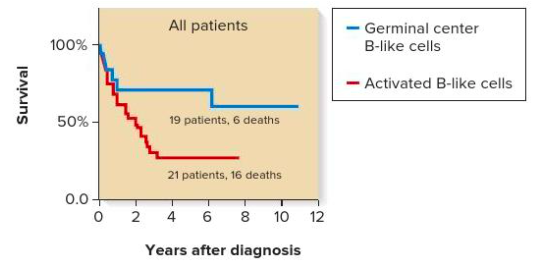
DNA microarray analysis led to the identification of two types of tumors from patients with diffuse large B-cell lymphoma, those originating from germinal center B-like cells and those originating from activated B-like cells. From the accompanying diagram, which group of patients had a higher survival rate?
Patients with tumors originating from germinal center B-like cells
The process of identifying the genes that play a role in the development of a specific type of cancer is called ______.
molecular profiling
Reason:
Gene therapy is used to treat inherited diseases after the responsible genes have been identified.
Molecular profiling is useful because ______.
drugs can be developed that will specifically target proteins encoded by cancer-causing gene mutations
tumors with similar appearances can be distinguished by differences in their genetic expression patterns
The study of genetic variations that cause differing responses to drugs is called ______.
pharmacogenetics
DNA microarrays can be used to ______.
compare gene activity in cancer cells and normal cells
Select all that apply
Which factors determine the proper dose of a drug to prescribe for a patient?
Rate of excretion of drug from the body
Ability of drug to be metabolized by the liver
Rate of transport of the drug into cells where the it will have its effect
Rate of transport of an orally-administered drug from the digestive tract into the bloodstream
Ability of drug to affect the function of a target protein
Which aspects of drug interaction within the body are affected by genetic variation in humans?
Drug metabolism
Drug transport
Ability of drug to affect its target protein
The anticoagulant drug warfarin is metabolized by a cytochrome P450 enzyme in the liver. Proper dosages must account for the amount that will be eliminated by the liver in order to provide a sufficient amount of circulating drug to prevent blood clots from forming. Four levels of warfarin metabolism have been identified in the human population, and from highest to lowest these are: ultrarapid, extensive, intermediate, and poor. Which metabolism type would require the lowest dosage of warfarin to prevent blood clotting?
Poor
Reason:
An unltrarapid metabolizer would require a high dose because the drug would be rapidly broken down in their body.
Pharmacogenetics is the ______.
study of genetic variations that cause differing responses to drugs
Genetic variation in the ability to metabolize the anticoagulant drug warfarin is shown by polymorphisms in the CYP2C9 gene, which encodes a liver enzyme called ___ P450.
cytochrome
Which of the following factors related to proper dosing of drugs would tend to reduce the amount of drug available to provide effective therapy for the patient?
Rate of excretion of drug from the body
Drug uptake and metabolism by the liver
In determining the proper dose of a drug to give a patient, which factors need to be considered? Whether the patient has a gene that ______.
encodes a target protein with a different shape that will not effectively bind to the drug
would slow transport of the drug from the digestive system to the bloodstream
would cause faster metabolism of the drug than in other patients
The anticoagulant drug warfarin is metabolized by a cytochrome P450 enzyme in the liver. Proper dosages must account for the amount that will be eliminated by the liver in order to provide a sufficient amount of circulating drug to prevent blood clots from forming. Four levels of warfarin metabolism have been identified in the human population, and from highest to lowest these are: ultrarapid, extensive, intermediate, and poor. Which metabolism type would require the highest dosage of warfarin to prevent blood clotting?
Ultrarapid
Reason:
A poor metabolizer would require a low dose because the drug would remain active in their body for a longer time.
Patients taking the anticoagulant drug warfarin vary in the ability to metabolize the drug due to polymorphisms in the CYP2C9 gene that encodes a ______ expressed in the liver.
cytochrome P450 enzyme
